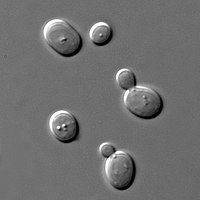
Photo from wikipedia
Hanseniaspora uvarum, a non-Saccharomyces cerevisiae species, has a crucial effect on the aroma characteristics of fruit wines, thus, attracting significant research interest in recent years. In this study, H. uvarum–Saccharomyces… Click to show full abstract
Hanseniaspora uvarum, a non-Saccharomyces cerevisiae species, has a crucial effect on the aroma characteristics of fruit wines, thus, attracting significant research interest in recent years. In this study, H. uvarum–Saccharomyces cerevisiae mixed fermentation was used to ferment Rosa roxburghii Tratt, blueberry fruit wine, and plum fruit wines using either a co-inoculated or a sequentially inoculated approach. The three fruit wines’ volatile aroma characteristics were analyzed by headspace–solid-phase microextraction–gas chromatography-mass spectrometry (HS–SPME–GC–MS). The results showed that the mixed inoculation of H. uvarum and S. cerevisiae reduced the alcoholic content of Kongxinli fruit wine. Moreover, H. uvarum–S. cerevisiae fermented Rosa roxburghii Tratt, blueberry, and plum fruit wines and further enriched their flavor compounds. The overall flavor characteristics of sequentially inoculated fruit wines differed significantly from those fermented with S. cerevisiae alone, although several similarities were also observed. Sequential inoculation of H. uvarum and S. cerevisiae positively affected the mellowness of the wine and achieved a better harmony of the overall wine flavors. Therefore, H. uvarum–Saccharomyces cerevisiae mixed fermentation can improve the complexity of the wines’ aromatic composition and empower them with a unique identity. In particular, H. uvarum–Saccharomyces cerevisiae blueberry wine produced by mixed fermentation had the widest variety and content of aroma compounds among the fermented wines. Therefore, H. uvarum–Saccharomyces cerevisiae mixed-fermentation inoculation in the three fermented fruit wines significantly increased the aroma compound variety and content, thus, enriching their aroma richness and complexity. This study is the first comparative evaluation of the aroma characteristics of different fruit wines fermented with a mixed inoculation of H. uvarum and S. cerevisiae and provides a preliminary guide for these fruit wines produced with non-Saccharomyces yeast.
Journal Title: Molecules
Year Published: 2022
Link to full text (if available)
Share on Social Media: Sign Up to like & get
recommendations!